ACCG315 Case Study: Navigating Ethics and Profit in Australian Retail
VerifiedAdded on 2023/06/07
|12
|3954
|332
Case Study
AI Summary
This case study delves into the ethical and financial challenges confronting the Australian retail sector, marked by pressures on sales growth and the need for cost reduction. It examines issues such as maintaining good faith in supplier relationships, the voluntary nature of the Food and Grocery Code of Conduct, and the appropriateness of decision-making power within organizations. The report further analyzes the impact of delayed payments to suppliers, the application of developed country employment standards in less developed countries, and the benefits of cost leadership models. It also explores integrated reporting, “at risk” remuneration components, and the importance of ethical behavior towards stakeholders. The study concludes by emphasizing the need for a balanced approach to profitability that considers ethical implications and stakeholder interests within the Australian retail landscape. Desklib provides students access to similar case studies and solutions.
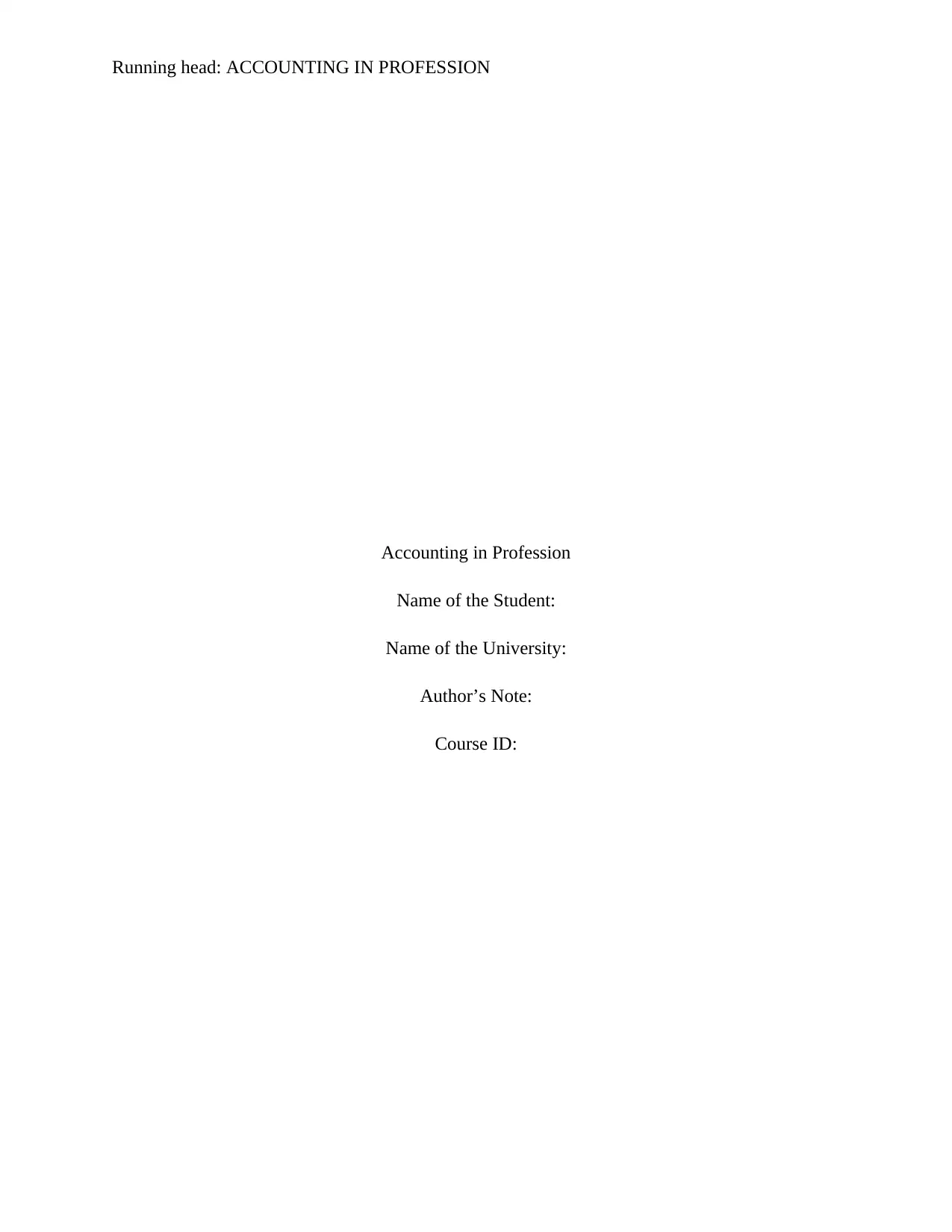
Running head: ACCOUNTING IN PROFESSION
Accounting in Profession
Name of the Student:
Name of the University:
Author’s Note:
Course ID:
Accounting in Profession
Name of the Student:
Name of the University:
Author’s Note:
Course ID:
Paraphrase This Document
Need a fresh take? Get an instant paraphrase of this document with our AI Paraphraser
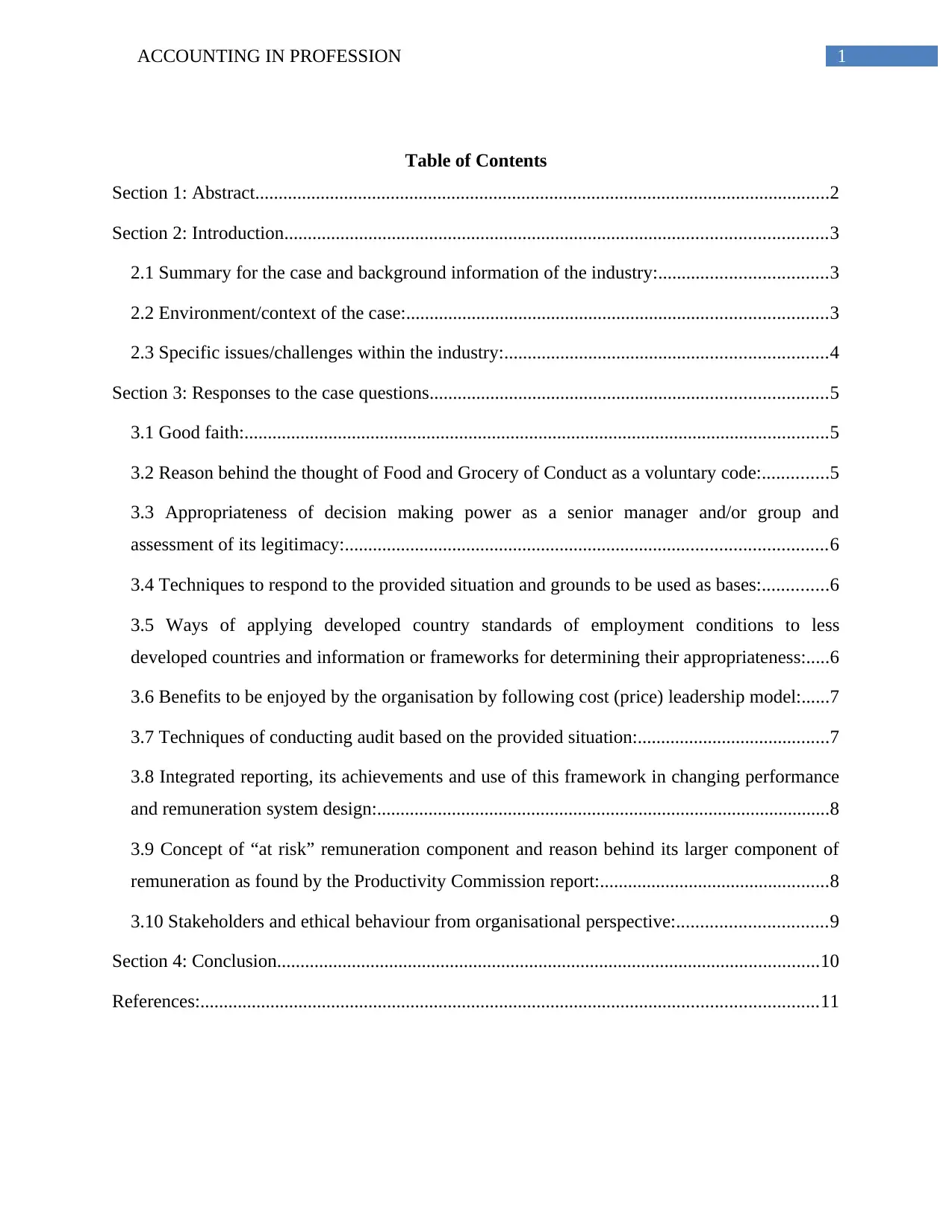
1ACCOUNTING IN PROFESSION
Table of Contents
Section 1: Abstract...........................................................................................................................2
Section 2: Introduction....................................................................................................................3
2.1 Summary for the case and background information of the industry:....................................3
2.2 Environment/context of the case:..........................................................................................3
2.3 Specific issues/challenges within the industry:.....................................................................4
Section 3: Responses to the case questions.....................................................................................5
3.1 Good faith:.............................................................................................................................5
3.2 Reason behind the thought of Food and Grocery of Conduct as a voluntary code:..............5
3.3 Appropriateness of decision making power as a senior manager and/or group and
assessment of its legitimacy:.......................................................................................................6
3.4 Techniques to respond to the provided situation and grounds to be used as bases:..............6
3.5 Ways of applying developed country standards of employment conditions to less
developed countries and information or frameworks for determining their appropriateness:.....6
3.6 Benefits to be enjoyed by the organisation by following cost (price) leadership model:......7
3.7 Techniques of conducting audit based on the provided situation:.........................................7
3.8 Integrated reporting, its achievements and use of this framework in changing performance
and remuneration system design:.................................................................................................8
3.9 Concept of “at risk” remuneration component and reason behind its larger component of
remuneration as found by the Productivity Commission report:.................................................8
3.10 Stakeholders and ethical behaviour from organisational perspective:................................9
Section 4: Conclusion....................................................................................................................10
References:....................................................................................................................................11
Table of Contents
Section 1: Abstract...........................................................................................................................2
Section 2: Introduction....................................................................................................................3
2.1 Summary for the case and background information of the industry:....................................3
2.2 Environment/context of the case:..........................................................................................3
2.3 Specific issues/challenges within the industry:.....................................................................4
Section 3: Responses to the case questions.....................................................................................5
3.1 Good faith:.............................................................................................................................5
3.2 Reason behind the thought of Food and Grocery of Conduct as a voluntary code:..............5
3.3 Appropriateness of decision making power as a senior manager and/or group and
assessment of its legitimacy:.......................................................................................................6
3.4 Techniques to respond to the provided situation and grounds to be used as bases:..............6
3.5 Ways of applying developed country standards of employment conditions to less
developed countries and information or frameworks for determining their appropriateness:.....6
3.6 Benefits to be enjoyed by the organisation by following cost (price) leadership model:......7
3.7 Techniques of conducting audit based on the provided situation:.........................................7
3.8 Integrated reporting, its achievements and use of this framework in changing performance
and remuneration system design:.................................................................................................8
3.9 Concept of “at risk” remuneration component and reason behind its larger component of
remuneration as found by the Productivity Commission report:.................................................8
3.10 Stakeholders and ethical behaviour from organisational perspective:................................9
Section 4: Conclusion....................................................................................................................10
References:....................................................................................................................................11
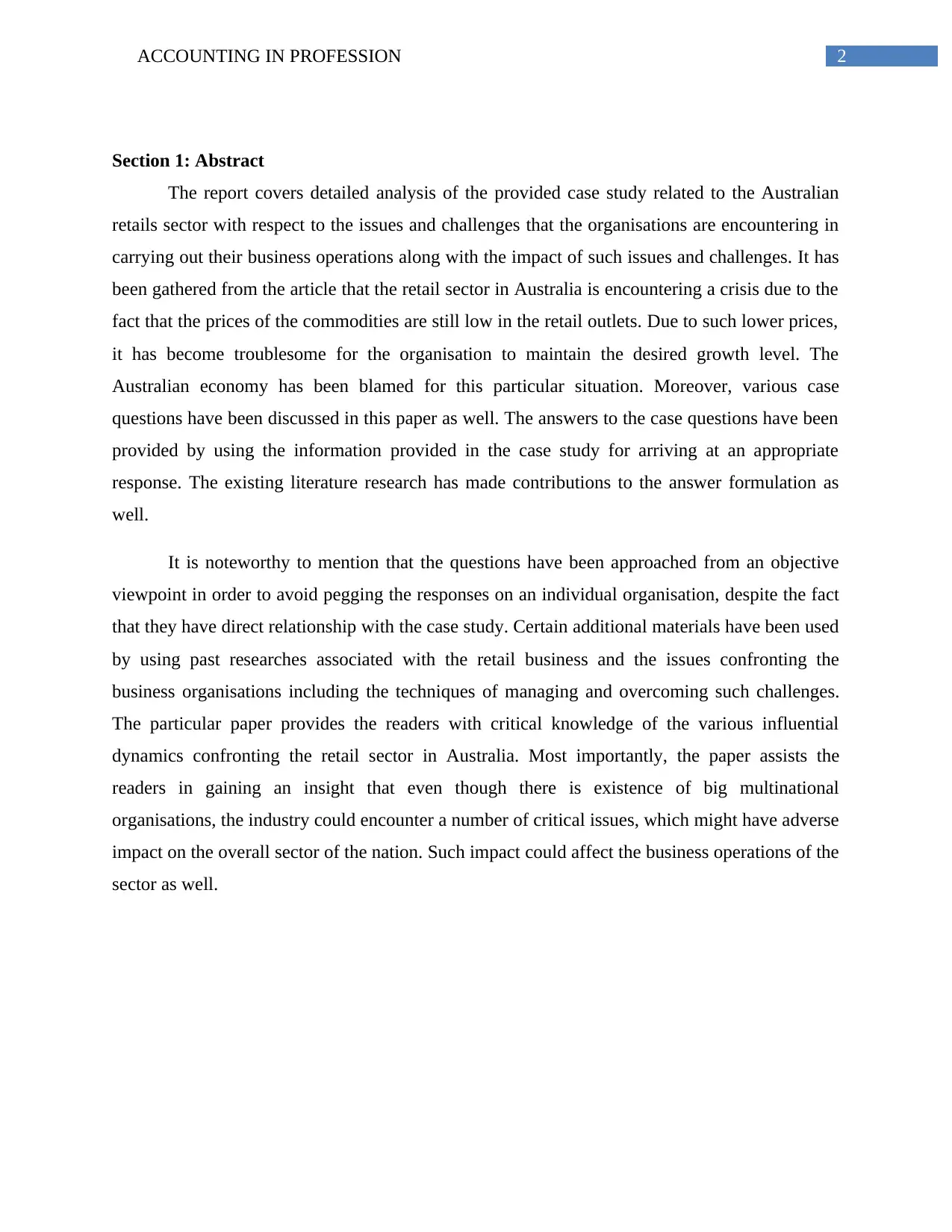
2ACCOUNTING IN PROFESSION
Section 1: Abstract
The report covers detailed analysis of the provided case study related to the Australian
retails sector with respect to the issues and challenges that the organisations are encountering in
carrying out their business operations along with the impact of such issues and challenges. It has
been gathered from the article that the retail sector in Australia is encountering a crisis due to the
fact that the prices of the commodities are still low in the retail outlets. Due to such lower prices,
it has become troublesome for the organisation to maintain the desired growth level. The
Australian economy has been blamed for this particular situation. Moreover, various case
questions have been discussed in this paper as well. The answers to the case questions have been
provided by using the information provided in the case study for arriving at an appropriate
response. The existing literature research has made contributions to the answer formulation as
well.
It is noteworthy to mention that the questions have been approached from an objective
viewpoint in order to avoid pegging the responses on an individual organisation, despite the fact
that they have direct relationship with the case study. Certain additional materials have been used
by using past researches associated with the retail business and the issues confronting the
business organisations including the techniques of managing and overcoming such challenges.
The particular paper provides the readers with critical knowledge of the various influential
dynamics confronting the retail sector in Australia. Most importantly, the paper assists the
readers in gaining an insight that even though there is existence of big multinational
organisations, the industry could encounter a number of critical issues, which might have adverse
impact on the overall sector of the nation. Such impact could affect the business operations of the
sector as well.
Section 1: Abstract
The report covers detailed analysis of the provided case study related to the Australian
retails sector with respect to the issues and challenges that the organisations are encountering in
carrying out their business operations along with the impact of such issues and challenges. It has
been gathered from the article that the retail sector in Australia is encountering a crisis due to the
fact that the prices of the commodities are still low in the retail outlets. Due to such lower prices,
it has become troublesome for the organisation to maintain the desired growth level. The
Australian economy has been blamed for this particular situation. Moreover, various case
questions have been discussed in this paper as well. The answers to the case questions have been
provided by using the information provided in the case study for arriving at an appropriate
response. The existing literature research has made contributions to the answer formulation as
well.
It is noteworthy to mention that the questions have been approached from an objective
viewpoint in order to avoid pegging the responses on an individual organisation, despite the fact
that they have direct relationship with the case study. Certain additional materials have been used
by using past researches associated with the retail business and the issues confronting the
business organisations including the techniques of managing and overcoming such challenges.
The particular paper provides the readers with critical knowledge of the various influential
dynamics confronting the retail sector in Australia. Most importantly, the paper assists the
readers in gaining an insight that even though there is existence of big multinational
organisations, the industry could encounter a number of critical issues, which might have adverse
impact on the overall sector of the nation. Such impact could affect the business operations of the
sector as well.
⊘ This is a preview!⊘
Do you want full access?
Subscribe today to unlock all pages.

Trusted by 1+ million students worldwide
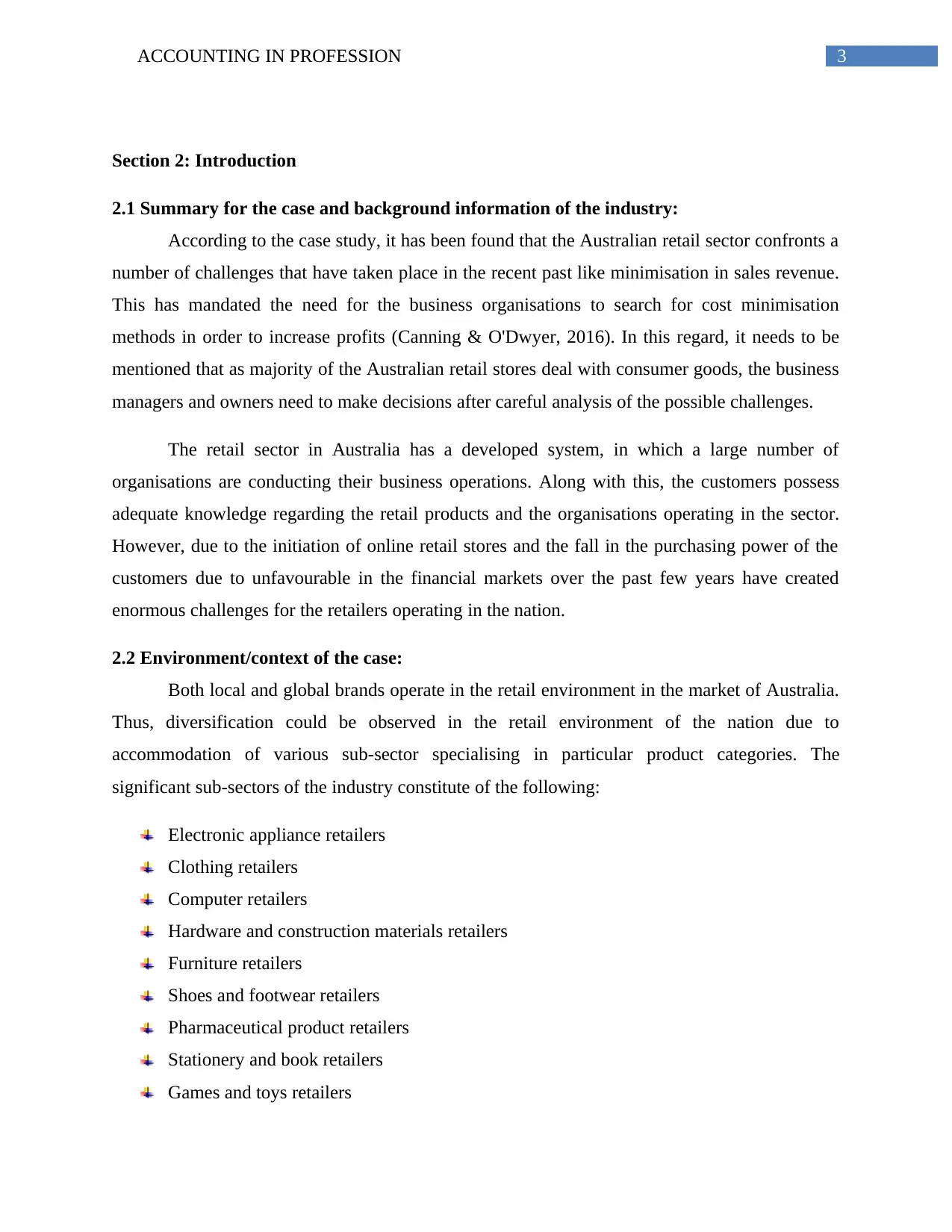
3ACCOUNTING IN PROFESSION
Section 2: Introduction
2.1 Summary for the case and background information of the industry:
According to the case study, it has been found that the Australian retail sector confronts a
number of challenges that have taken place in the recent past like minimisation in sales revenue.
This has mandated the need for the business organisations to search for cost minimisation
methods in order to increase profits (Canning & O'Dwyer, 2016). In this regard, it needs to be
mentioned that as majority of the Australian retail stores deal with consumer goods, the business
managers and owners need to make decisions after careful analysis of the possible challenges.
The retail sector in Australia has a developed system, in which a large number of
organisations are conducting their business operations. Along with this, the customers possess
adequate knowledge regarding the retail products and the organisations operating in the sector.
However, due to the initiation of online retail stores and the fall in the purchasing power of the
customers due to unfavourable in the financial markets over the past few years have created
enormous challenges for the retailers operating in the nation.
2.2 Environment/context of the case:
Both local and global brands operate in the retail environment in the market of Australia.
Thus, diversification could be observed in the retail environment of the nation due to
accommodation of various sub-sector specialising in particular product categories. The
significant sub-sectors of the industry constitute of the following:
Electronic appliance retailers
Clothing retailers
Computer retailers
Hardware and construction materials retailers
Furniture retailers
Shoes and footwear retailers
Pharmaceutical product retailers
Stationery and book retailers
Games and toys retailers
Section 2: Introduction
2.1 Summary for the case and background information of the industry:
According to the case study, it has been found that the Australian retail sector confronts a
number of challenges that have taken place in the recent past like minimisation in sales revenue.
This has mandated the need for the business organisations to search for cost minimisation
methods in order to increase profits (Canning & O'Dwyer, 2016). In this regard, it needs to be
mentioned that as majority of the Australian retail stores deal with consumer goods, the business
managers and owners need to make decisions after careful analysis of the possible challenges.
The retail sector in Australia has a developed system, in which a large number of
organisations are conducting their business operations. Along with this, the customers possess
adequate knowledge regarding the retail products and the organisations operating in the sector.
However, due to the initiation of online retail stores and the fall in the purchasing power of the
customers due to unfavourable in the financial markets over the past few years have created
enormous challenges for the retailers operating in the nation.
2.2 Environment/context of the case:
Both local and global brands operate in the retail environment in the market of Australia.
Thus, diversification could be observed in the retail environment of the nation due to
accommodation of various sub-sector specialising in particular product categories. The
significant sub-sectors of the industry constitute of the following:
Electronic appliance retailers
Clothing retailers
Computer retailers
Hardware and construction materials retailers
Furniture retailers
Shoes and footwear retailers
Pharmaceutical product retailers
Stationery and book retailers
Games and toys retailers
Paraphrase This Document
Need a fresh take? Get an instant paraphrase of this document with our AI Paraphraser
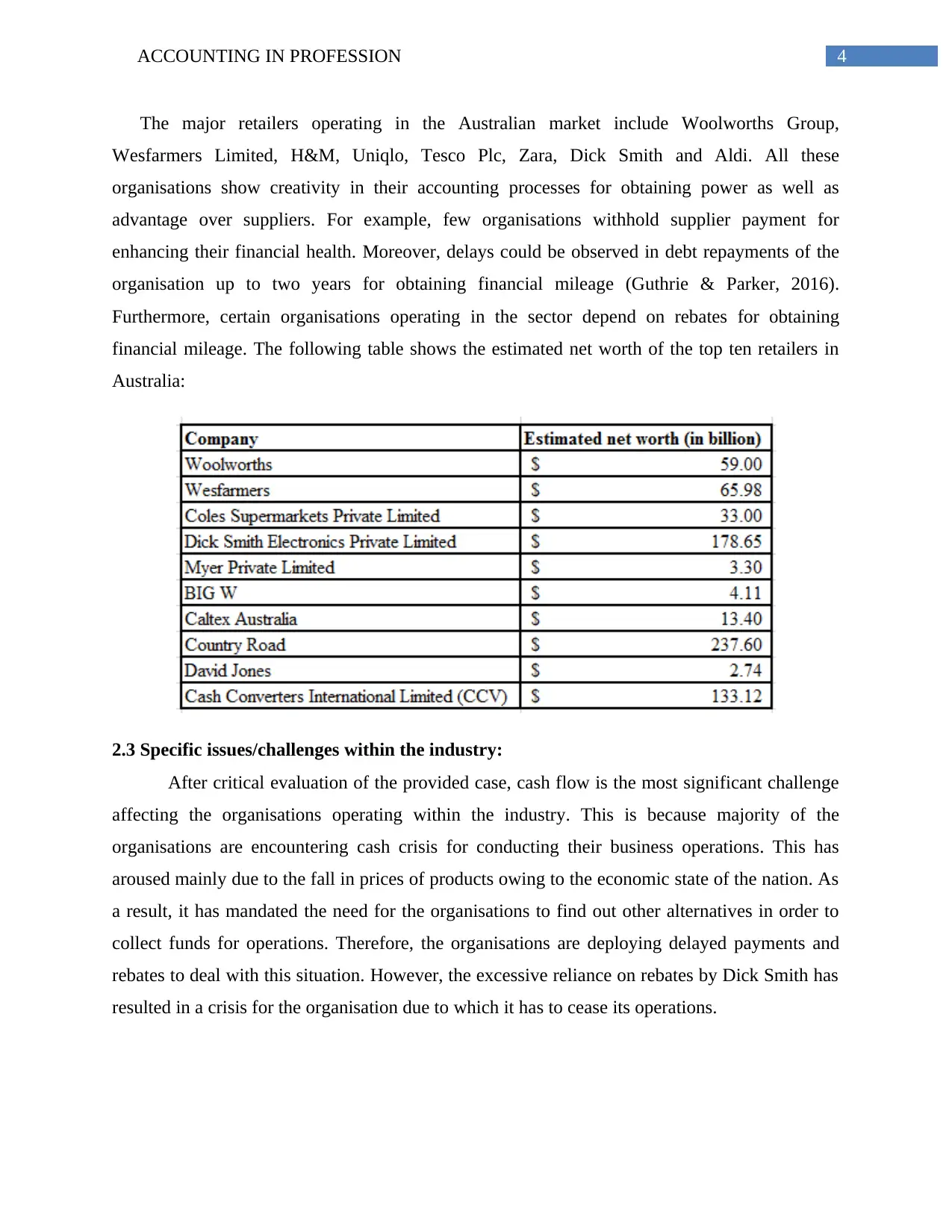
4ACCOUNTING IN PROFESSION
The major retailers operating in the Australian market include Woolworths Group,
Wesfarmers Limited, H&M, Uniqlo, Tesco Plc, Zara, Dick Smith and Aldi. All these
organisations show creativity in their accounting processes for obtaining power as well as
advantage over suppliers. For example, few organisations withhold supplier payment for
enhancing their financial health. Moreover, delays could be observed in debt repayments of the
organisation up to two years for obtaining financial mileage (Guthrie & Parker, 2016).
Furthermore, certain organisations operating in the sector depend on rebates for obtaining
financial mileage. The following table shows the estimated net worth of the top ten retailers in
Australia:
2.3 Specific issues/challenges within the industry:
After critical evaluation of the provided case, cash flow is the most significant challenge
affecting the organisations operating within the industry. This is because majority of the
organisations are encountering cash crisis for conducting their business operations. This has
aroused mainly due to the fall in prices of products owing to the economic state of the nation. As
a result, it has mandated the need for the organisations to find out other alternatives in order to
collect funds for operations. Therefore, the organisations are deploying delayed payments and
rebates to deal with this situation. However, the excessive reliance on rebates by Dick Smith has
resulted in a crisis for the organisation due to which it has to cease its operations.
The major retailers operating in the Australian market include Woolworths Group,
Wesfarmers Limited, H&M, Uniqlo, Tesco Plc, Zara, Dick Smith and Aldi. All these
organisations show creativity in their accounting processes for obtaining power as well as
advantage over suppliers. For example, few organisations withhold supplier payment for
enhancing their financial health. Moreover, delays could be observed in debt repayments of the
organisation up to two years for obtaining financial mileage (Guthrie & Parker, 2016).
Furthermore, certain organisations operating in the sector depend on rebates for obtaining
financial mileage. The following table shows the estimated net worth of the top ten retailers in
Australia:
2.3 Specific issues/challenges within the industry:
After critical evaluation of the provided case, cash flow is the most significant challenge
affecting the organisations operating within the industry. This is because majority of the
organisations are encountering cash crisis for conducting their business operations. This has
aroused mainly due to the fall in prices of products owing to the economic state of the nation. As
a result, it has mandated the need for the organisations to find out other alternatives in order to
collect funds for operations. Therefore, the organisations are deploying delayed payments and
rebates to deal with this situation. However, the excessive reliance on rebates by Dick Smith has
resulted in a crisis for the organisation due to which it has to cease its operations.
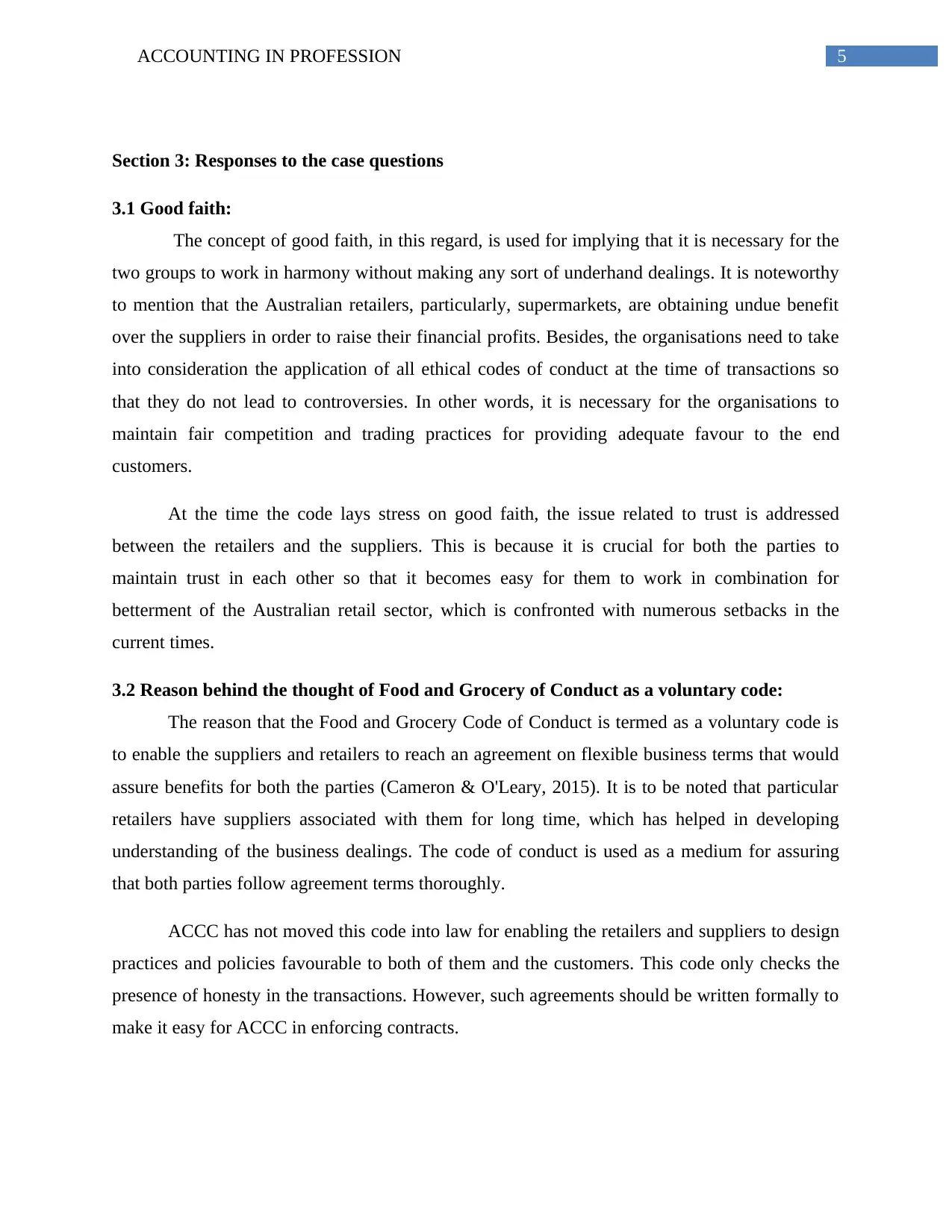
5ACCOUNTING IN PROFESSION
Section 3: Responses to the case questions
3.1 Good faith:
The concept of good faith, in this regard, is used for implying that it is necessary for the
two groups to work in harmony without making any sort of underhand dealings. It is noteworthy
to mention that the Australian retailers, particularly, supermarkets, are obtaining undue benefit
over the suppliers in order to raise their financial profits. Besides, the organisations need to take
into consideration the application of all ethical codes of conduct at the time of transactions so
that they do not lead to controversies. In other words, it is necessary for the organisations to
maintain fair competition and trading practices for providing adequate favour to the end
customers.
At the time the code lays stress on good faith, the issue related to trust is addressed
between the retailers and the suppliers. This is because it is crucial for both the parties to
maintain trust in each other so that it becomes easy for them to work in combination for
betterment of the Australian retail sector, which is confronted with numerous setbacks in the
current times.
3.2 Reason behind the thought of Food and Grocery of Conduct as a voluntary code:
The reason that the Food and Grocery Code of Conduct is termed as a voluntary code is
to enable the suppliers and retailers to reach an agreement on flexible business terms that would
assure benefits for both the parties (Cameron & O'Leary, 2015). It is to be noted that particular
retailers have suppliers associated with them for long time, which has helped in developing
understanding of the business dealings. The code of conduct is used as a medium for assuring
that both parties follow agreement terms thoroughly.
ACCC has not moved this code into law for enabling the retailers and suppliers to design
practices and policies favourable to both of them and the customers. This code only checks the
presence of honesty in the transactions. However, such agreements should be written formally to
make it easy for ACCC in enforcing contracts.
Section 3: Responses to the case questions
3.1 Good faith:
The concept of good faith, in this regard, is used for implying that it is necessary for the
two groups to work in harmony without making any sort of underhand dealings. It is noteworthy
to mention that the Australian retailers, particularly, supermarkets, are obtaining undue benefit
over the suppliers in order to raise their financial profits. Besides, the organisations need to take
into consideration the application of all ethical codes of conduct at the time of transactions so
that they do not lead to controversies. In other words, it is necessary for the organisations to
maintain fair competition and trading practices for providing adequate favour to the end
customers.
At the time the code lays stress on good faith, the issue related to trust is addressed
between the retailers and the suppliers. This is because it is crucial for both the parties to
maintain trust in each other so that it becomes easy for them to work in combination for
betterment of the Australian retail sector, which is confronted with numerous setbacks in the
current times.
3.2 Reason behind the thought of Food and Grocery of Conduct as a voluntary code:
The reason that the Food and Grocery Code of Conduct is termed as a voluntary code is
to enable the suppliers and retailers to reach an agreement on flexible business terms that would
assure benefits for both the parties (Cameron & O'Leary, 2015). It is to be noted that particular
retailers have suppliers associated with them for long time, which has helped in developing
understanding of the business dealings. The code of conduct is used as a medium for assuring
that both parties follow agreement terms thoroughly.
ACCC has not moved this code into law for enabling the retailers and suppliers to design
practices and policies favourable to both of them and the customers. This code only checks the
presence of honesty in the transactions. However, such agreements should be written formally to
make it easy for ACCC in enforcing contracts.
⊘ This is a preview!⊘
Do you want full access?
Subscribe today to unlock all pages.

Trusted by 1+ million students worldwide
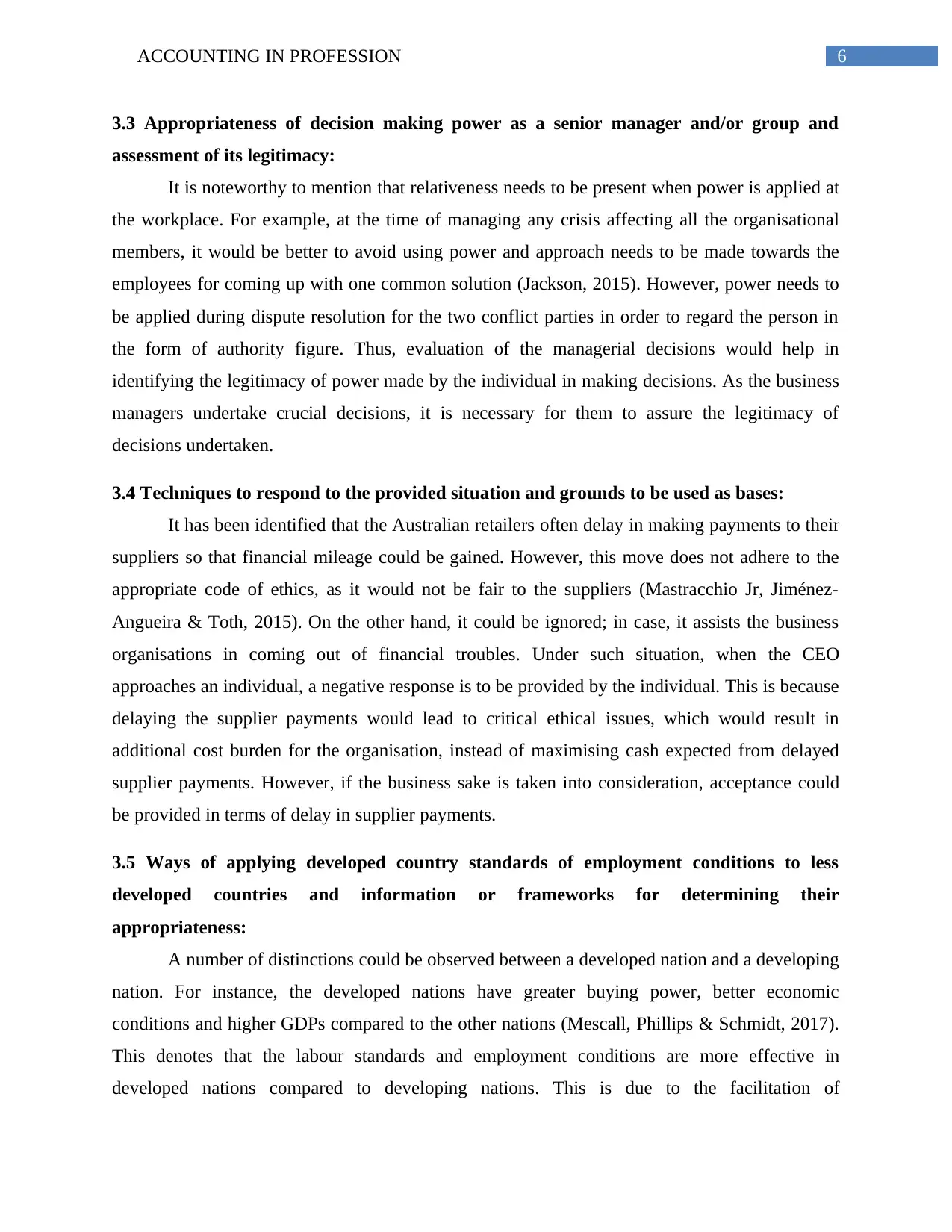
6ACCOUNTING IN PROFESSION
3.3 Appropriateness of decision making power as a senior manager and/or group and
assessment of its legitimacy:
It is noteworthy to mention that relativeness needs to be present when power is applied at
the workplace. For example, at the time of managing any crisis affecting all the organisational
members, it would be better to avoid using power and approach needs to be made towards the
employees for coming up with one common solution (Jackson, 2015). However, power needs to
be applied during dispute resolution for the two conflict parties in order to regard the person in
the form of authority figure. Thus, evaluation of the managerial decisions would help in
identifying the legitimacy of power made by the individual in making decisions. As the business
managers undertake crucial decisions, it is necessary for them to assure the legitimacy of
decisions undertaken.
3.4 Techniques to respond to the provided situation and grounds to be used as bases:
It has been identified that the Australian retailers often delay in making payments to their
suppliers so that financial mileage could be gained. However, this move does not adhere to the
appropriate code of ethics, as it would not be fair to the suppliers (Mastracchio Jr, Jiménez-
Angueira & Toth, 2015). On the other hand, it could be ignored; in case, it assists the business
organisations in coming out of financial troubles. Under such situation, when the CEO
approaches an individual, a negative response is to be provided by the individual. This is because
delaying the supplier payments would lead to critical ethical issues, which would result in
additional cost burden for the organisation, instead of maximising cash expected from delayed
supplier payments. However, if the business sake is taken into consideration, acceptance could
be provided in terms of delay in supplier payments.
3.5 Ways of applying developed country standards of employment conditions to less
developed countries and information or frameworks for determining their
appropriateness:
A number of distinctions could be observed between a developed nation and a developing
nation. For instance, the developed nations have greater buying power, better economic
conditions and higher GDPs compared to the other nations (Mescall, Phillips & Schmidt, 2017).
This denotes that the labour standards and employment conditions are more effective in
developed nations compared to developing nations. This is due to the facilitation of
3.3 Appropriateness of decision making power as a senior manager and/or group and
assessment of its legitimacy:
It is noteworthy to mention that relativeness needs to be present when power is applied at
the workplace. For example, at the time of managing any crisis affecting all the organisational
members, it would be better to avoid using power and approach needs to be made towards the
employees for coming up with one common solution (Jackson, 2015). However, power needs to
be applied during dispute resolution for the two conflict parties in order to regard the person in
the form of authority figure. Thus, evaluation of the managerial decisions would help in
identifying the legitimacy of power made by the individual in making decisions. As the business
managers undertake crucial decisions, it is necessary for them to assure the legitimacy of
decisions undertaken.
3.4 Techniques to respond to the provided situation and grounds to be used as bases:
It has been identified that the Australian retailers often delay in making payments to their
suppliers so that financial mileage could be gained. However, this move does not adhere to the
appropriate code of ethics, as it would not be fair to the suppliers (Mastracchio Jr, Jiménez-
Angueira & Toth, 2015). On the other hand, it could be ignored; in case, it assists the business
organisations in coming out of financial troubles. Under such situation, when the CEO
approaches an individual, a negative response is to be provided by the individual. This is because
delaying the supplier payments would lead to critical ethical issues, which would result in
additional cost burden for the organisation, instead of maximising cash expected from delayed
supplier payments. However, if the business sake is taken into consideration, acceptance could
be provided in terms of delay in supplier payments.
3.5 Ways of applying developed country standards of employment conditions to less
developed countries and information or frameworks for determining their
appropriateness:
A number of distinctions could be observed between a developed nation and a developing
nation. For instance, the developed nations have greater buying power, better economic
conditions and higher GDPs compared to the other nations (Mescall, Phillips & Schmidt, 2017).
This denotes that the labour standards and employment conditions are more effective in
developed nations compared to developing nations. This is due to the facilitation of
Paraphrase This Document
Need a fresh take? Get an instant paraphrase of this document with our AI Paraphraser
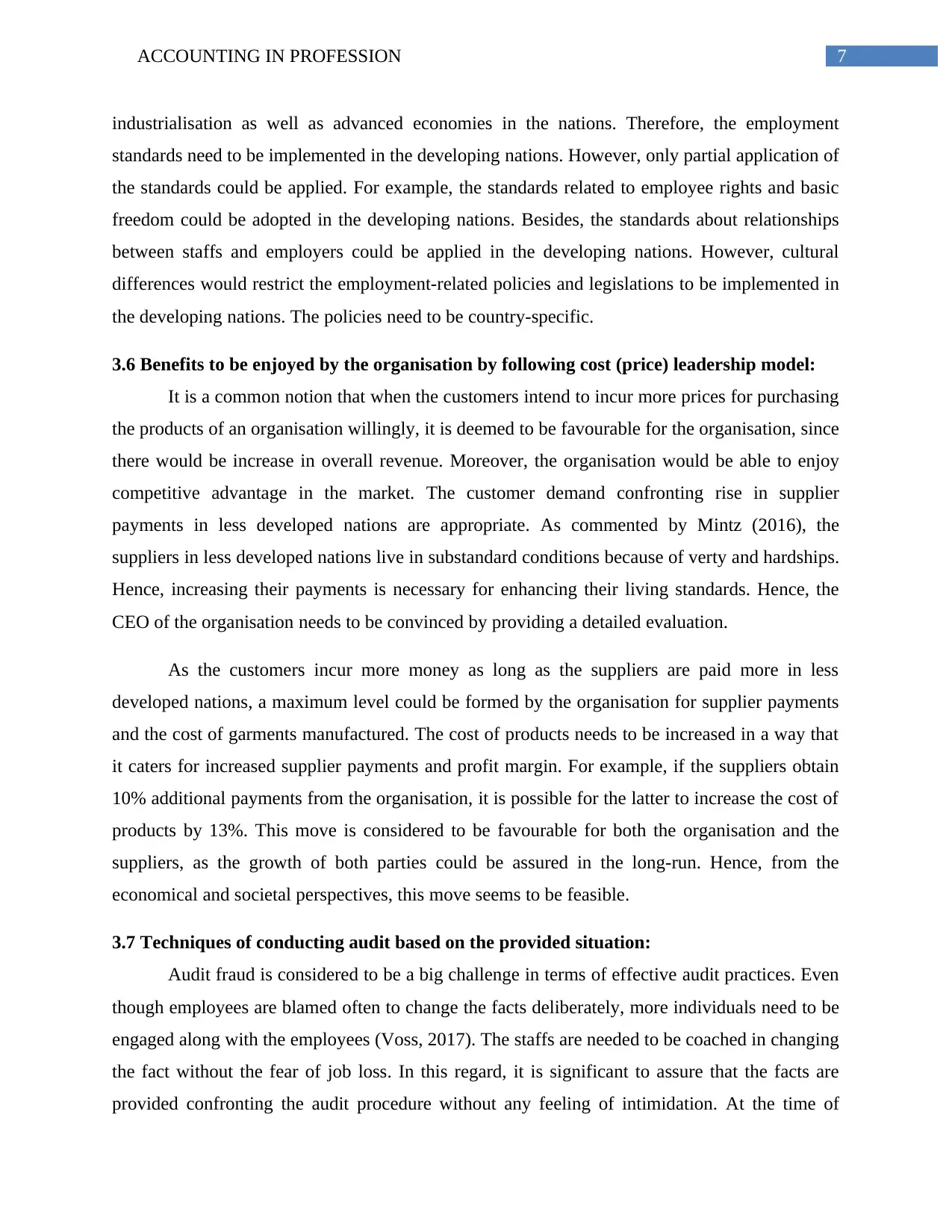
7ACCOUNTING IN PROFESSION
industrialisation as well as advanced economies in the nations. Therefore, the employment
standards need to be implemented in the developing nations. However, only partial application of
the standards could be applied. For example, the standards related to employee rights and basic
freedom could be adopted in the developing nations. Besides, the standards about relationships
between staffs and employers could be applied in the developing nations. However, cultural
differences would restrict the employment-related policies and legislations to be implemented in
the developing nations. The policies need to be country-specific.
3.6 Benefits to be enjoyed by the organisation by following cost (price) leadership model:
It is a common notion that when the customers intend to incur more prices for purchasing
the products of an organisation willingly, it is deemed to be favourable for the organisation, since
there would be increase in overall revenue. Moreover, the organisation would be able to enjoy
competitive advantage in the market. The customer demand confronting rise in supplier
payments in less developed nations are appropriate. As commented by Mintz (2016), the
suppliers in less developed nations live in substandard conditions because of verty and hardships.
Hence, increasing their payments is necessary for enhancing their living standards. Hence, the
CEO of the organisation needs to be convinced by providing a detailed evaluation.
As the customers incur more money as long as the suppliers are paid more in less
developed nations, a maximum level could be formed by the organisation for supplier payments
and the cost of garments manufactured. The cost of products needs to be increased in a way that
it caters for increased supplier payments and profit margin. For example, if the suppliers obtain
10% additional payments from the organisation, it is possible for the latter to increase the cost of
products by 13%. This move is considered to be favourable for both the organisation and the
suppliers, as the growth of both parties could be assured in the long-run. Hence, from the
economical and societal perspectives, this move seems to be feasible.
3.7 Techniques of conducting audit based on the provided situation:
Audit fraud is considered to be a big challenge in terms of effective audit practices. Even
though employees are blamed often to change the facts deliberately, more individuals need to be
engaged along with the employees (Voss, 2017). The staffs are needed to be coached in changing
the fact without the fear of job loss. In this regard, it is significant to assure that the facts are
provided confronting the audit procedure without any feeling of intimidation. At the time of
industrialisation as well as advanced economies in the nations. Therefore, the employment
standards need to be implemented in the developing nations. However, only partial application of
the standards could be applied. For example, the standards related to employee rights and basic
freedom could be adopted in the developing nations. Besides, the standards about relationships
between staffs and employers could be applied in the developing nations. However, cultural
differences would restrict the employment-related policies and legislations to be implemented in
the developing nations. The policies need to be country-specific.
3.6 Benefits to be enjoyed by the organisation by following cost (price) leadership model:
It is a common notion that when the customers intend to incur more prices for purchasing
the products of an organisation willingly, it is deemed to be favourable for the organisation, since
there would be increase in overall revenue. Moreover, the organisation would be able to enjoy
competitive advantage in the market. The customer demand confronting rise in supplier
payments in less developed nations are appropriate. As commented by Mintz (2016), the
suppliers in less developed nations live in substandard conditions because of verty and hardships.
Hence, increasing their payments is necessary for enhancing their living standards. Hence, the
CEO of the organisation needs to be convinced by providing a detailed evaluation.
As the customers incur more money as long as the suppliers are paid more in less
developed nations, a maximum level could be formed by the organisation for supplier payments
and the cost of garments manufactured. The cost of products needs to be increased in a way that
it caters for increased supplier payments and profit margin. For example, if the suppliers obtain
10% additional payments from the organisation, it is possible for the latter to increase the cost of
products by 13%. This move is considered to be favourable for both the organisation and the
suppliers, as the growth of both parties could be assured in the long-run. Hence, from the
economical and societal perspectives, this move seems to be feasible.
3.7 Techniques of conducting audit based on the provided situation:
Audit fraud is considered to be a big challenge in terms of effective audit practices. Even
though employees are blamed often to change the facts deliberately, more individuals need to be
engaged along with the employees (Voss, 2017). The staffs are needed to be coached in changing
the fact without the fear of job loss. In this regard, it is significant to assure that the facts are
provided confronting the audit procedure without any feeling of intimidation. At the time of
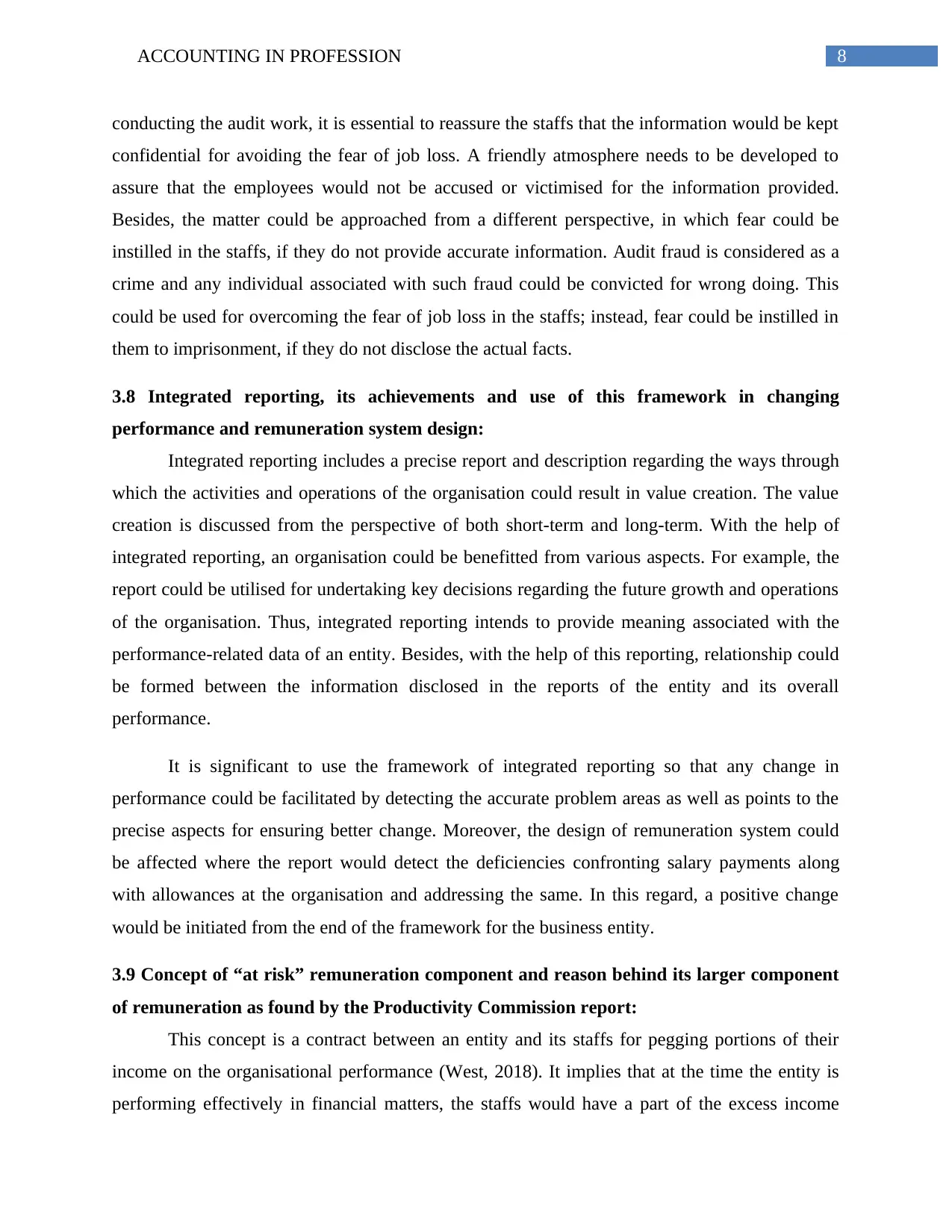
8ACCOUNTING IN PROFESSION
conducting the audit work, it is essential to reassure the staffs that the information would be kept
confidential for avoiding the fear of job loss. A friendly atmosphere needs to be developed to
assure that the employees would not be accused or victimised for the information provided.
Besides, the matter could be approached from a different perspective, in which fear could be
instilled in the staffs, if they do not provide accurate information. Audit fraud is considered as a
crime and any individual associated with such fraud could be convicted for wrong doing. This
could be used for overcoming the fear of job loss in the staffs; instead, fear could be instilled in
them to imprisonment, if they do not disclose the actual facts.
3.8 Integrated reporting, its achievements and use of this framework in changing
performance and remuneration system design:
Integrated reporting includes a precise report and description regarding the ways through
which the activities and operations of the organisation could result in value creation. The value
creation is discussed from the perspective of both short-term and long-term. With the help of
integrated reporting, an organisation could be benefitted from various aspects. For example, the
report could be utilised for undertaking key decisions regarding the future growth and operations
of the organisation. Thus, integrated reporting intends to provide meaning associated with the
performance-related data of an entity. Besides, with the help of this reporting, relationship could
be formed between the information disclosed in the reports of the entity and its overall
performance.
It is significant to use the framework of integrated reporting so that any change in
performance could be facilitated by detecting the accurate problem areas as well as points to the
precise aspects for ensuring better change. Moreover, the design of remuneration system could
be affected where the report would detect the deficiencies confronting salary payments along
with allowances at the organisation and addressing the same. In this regard, a positive change
would be initiated from the end of the framework for the business entity.
3.9 Concept of “at risk” remuneration component and reason behind its larger component
of remuneration as found by the Productivity Commission report:
This concept is a contract between an entity and its staffs for pegging portions of their
income on the organisational performance (West, 2018). It implies that at the time the entity is
performing effectively in financial matters, the staffs would have a part of the excess income
conducting the audit work, it is essential to reassure the staffs that the information would be kept
confidential for avoiding the fear of job loss. A friendly atmosphere needs to be developed to
assure that the employees would not be accused or victimised for the information provided.
Besides, the matter could be approached from a different perspective, in which fear could be
instilled in the staffs, if they do not provide accurate information. Audit fraud is considered as a
crime and any individual associated with such fraud could be convicted for wrong doing. This
could be used for overcoming the fear of job loss in the staffs; instead, fear could be instilled in
them to imprisonment, if they do not disclose the actual facts.
3.8 Integrated reporting, its achievements and use of this framework in changing
performance and remuneration system design:
Integrated reporting includes a precise report and description regarding the ways through
which the activities and operations of the organisation could result in value creation. The value
creation is discussed from the perspective of both short-term and long-term. With the help of
integrated reporting, an organisation could be benefitted from various aspects. For example, the
report could be utilised for undertaking key decisions regarding the future growth and operations
of the organisation. Thus, integrated reporting intends to provide meaning associated with the
performance-related data of an entity. Besides, with the help of this reporting, relationship could
be formed between the information disclosed in the reports of the entity and its overall
performance.
It is significant to use the framework of integrated reporting so that any change in
performance could be facilitated by detecting the accurate problem areas as well as points to the
precise aspects for ensuring better change. Moreover, the design of remuneration system could
be affected where the report would detect the deficiencies confronting salary payments along
with allowances at the organisation and addressing the same. In this regard, a positive change
would be initiated from the end of the framework for the business entity.
3.9 Concept of “at risk” remuneration component and reason behind its larger component
of remuneration as found by the Productivity Commission report:
This concept is a contract between an entity and its staffs for pegging portions of their
income on the organisational performance (West, 2018). It implies that at the time the entity is
performing effectively in financial matters, the staffs would have a part of the excess income
⊘ This is a preview!⊘
Do you want full access?
Subscribe today to unlock all pages.

Trusted by 1+ million students worldwide
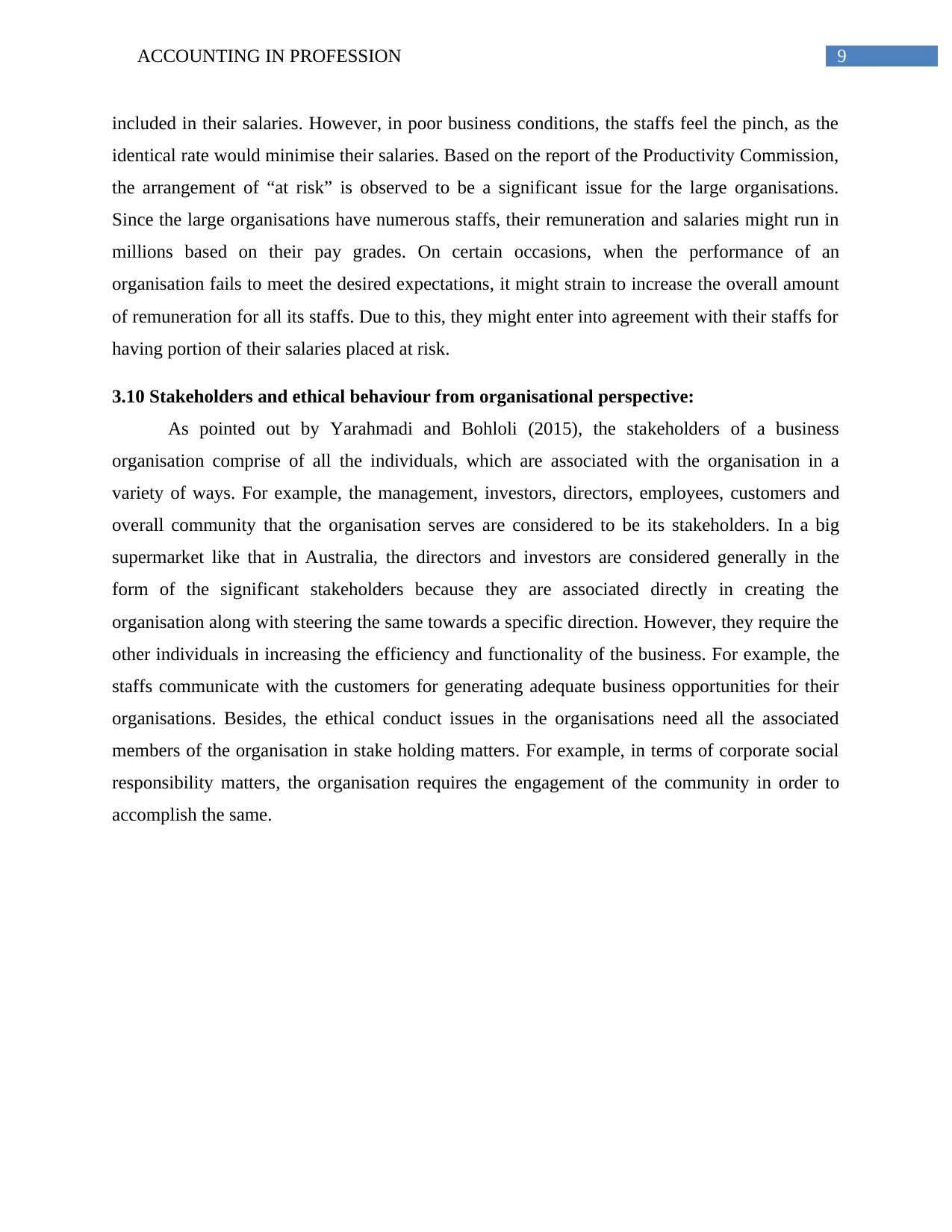
9ACCOUNTING IN PROFESSION
included in their salaries. However, in poor business conditions, the staffs feel the pinch, as the
identical rate would minimise their salaries. Based on the report of the Productivity Commission,
the arrangement of “at risk” is observed to be a significant issue for the large organisations.
Since the large organisations have numerous staffs, their remuneration and salaries might run in
millions based on their pay grades. On certain occasions, when the performance of an
organisation fails to meet the desired expectations, it might strain to increase the overall amount
of remuneration for all its staffs. Due to this, they might enter into agreement with their staffs for
having portion of their salaries placed at risk.
3.10 Stakeholders and ethical behaviour from organisational perspective:
As pointed out by Yarahmadi and Bohloli (2015), the stakeholders of a business
organisation comprise of all the individuals, which are associated with the organisation in a
variety of ways. For example, the management, investors, directors, employees, customers and
overall community that the organisation serves are considered to be its stakeholders. In a big
supermarket like that in Australia, the directors and investors are considered generally in the
form of the significant stakeholders because they are associated directly in creating the
organisation along with steering the same towards a specific direction. However, they require the
other individuals in increasing the efficiency and functionality of the business. For example, the
staffs communicate with the customers for generating adequate business opportunities for their
organisations. Besides, the ethical conduct issues in the organisations need all the associated
members of the organisation in stake holding matters. For example, in terms of corporate social
responsibility matters, the organisation requires the engagement of the community in order to
accomplish the same.
included in their salaries. However, in poor business conditions, the staffs feel the pinch, as the
identical rate would minimise their salaries. Based on the report of the Productivity Commission,
the arrangement of “at risk” is observed to be a significant issue for the large organisations.
Since the large organisations have numerous staffs, their remuneration and salaries might run in
millions based on their pay grades. On certain occasions, when the performance of an
organisation fails to meet the desired expectations, it might strain to increase the overall amount
of remuneration for all its staffs. Due to this, they might enter into agreement with their staffs for
having portion of their salaries placed at risk.
3.10 Stakeholders and ethical behaviour from organisational perspective:
As pointed out by Yarahmadi and Bohloli (2015), the stakeholders of a business
organisation comprise of all the individuals, which are associated with the organisation in a
variety of ways. For example, the management, investors, directors, employees, customers and
overall community that the organisation serves are considered to be its stakeholders. In a big
supermarket like that in Australia, the directors and investors are considered generally in the
form of the significant stakeholders because they are associated directly in creating the
organisation along with steering the same towards a specific direction. However, they require the
other individuals in increasing the efficiency and functionality of the business. For example, the
staffs communicate with the customers for generating adequate business opportunities for their
organisations. Besides, the ethical conduct issues in the organisations need all the associated
members of the organisation in stake holding matters. For example, in terms of corporate social
responsibility matters, the organisation requires the engagement of the community in order to
accomplish the same.
Paraphrase This Document
Need a fresh take? Get an instant paraphrase of this document with our AI Paraphraser
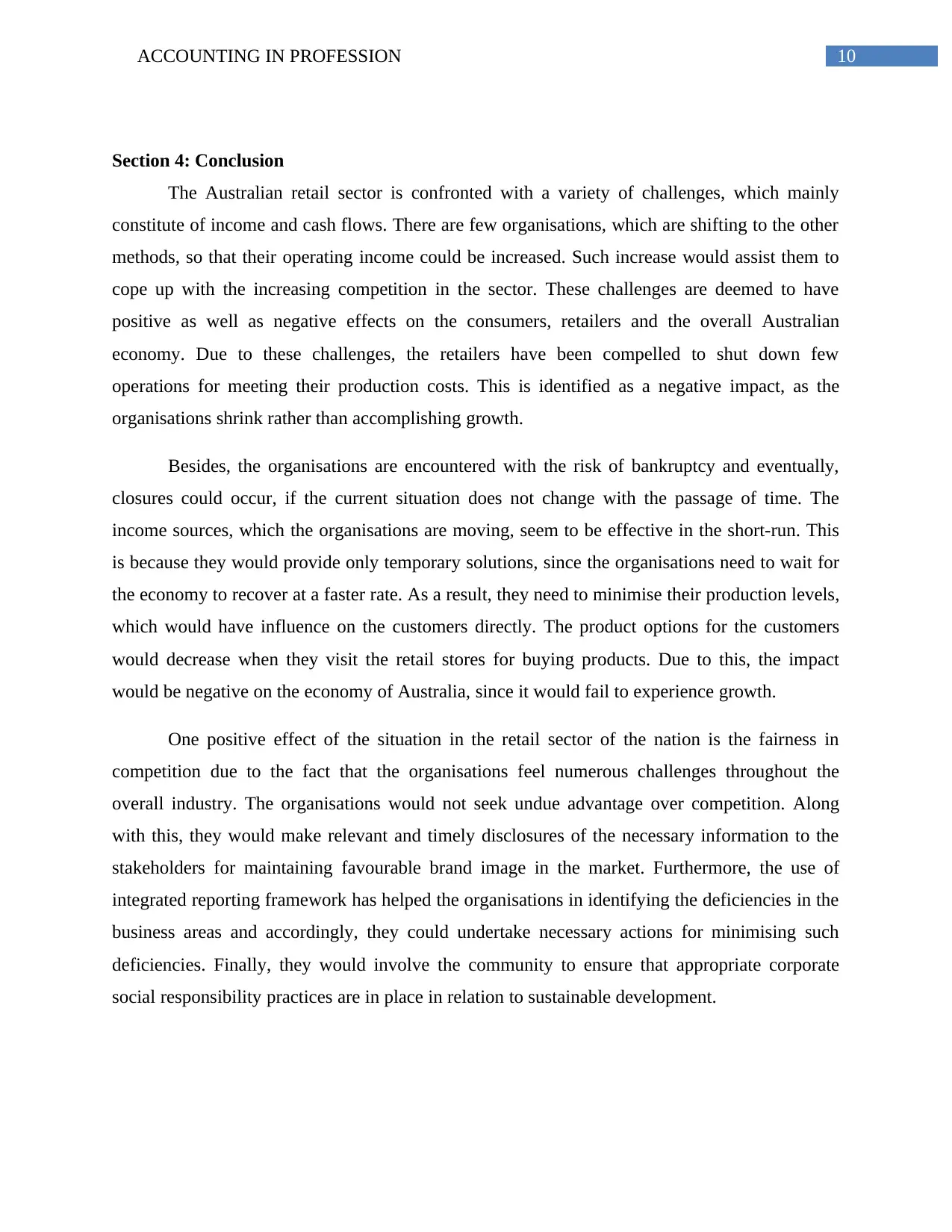
10ACCOUNTING IN PROFESSION
Section 4: Conclusion
The Australian retail sector is confronted with a variety of challenges, which mainly
constitute of income and cash flows. There are few organisations, which are shifting to the other
methods, so that their operating income could be increased. Such increase would assist them to
cope up with the increasing competition in the sector. These challenges are deemed to have
positive as well as negative effects on the consumers, retailers and the overall Australian
economy. Due to these challenges, the retailers have been compelled to shut down few
operations for meeting their production costs. This is identified as a negative impact, as the
organisations shrink rather than accomplishing growth.
Besides, the organisations are encountered with the risk of bankruptcy and eventually,
closures could occur, if the current situation does not change with the passage of time. The
income sources, which the organisations are moving, seem to be effective in the short-run. This
is because they would provide only temporary solutions, since the organisations need to wait for
the economy to recover at a faster rate. As a result, they need to minimise their production levels,
which would have influence on the customers directly. The product options for the customers
would decrease when they visit the retail stores for buying products. Due to this, the impact
would be negative on the economy of Australia, since it would fail to experience growth.
One positive effect of the situation in the retail sector of the nation is the fairness in
competition due to the fact that the organisations feel numerous challenges throughout the
overall industry. The organisations would not seek undue advantage over competition. Along
with this, they would make relevant and timely disclosures of the necessary information to the
stakeholders for maintaining favourable brand image in the market. Furthermore, the use of
integrated reporting framework has helped the organisations in identifying the deficiencies in the
business areas and accordingly, they could undertake necessary actions for minimising such
deficiencies. Finally, they would involve the community to ensure that appropriate corporate
social responsibility practices are in place in relation to sustainable development.
Section 4: Conclusion
The Australian retail sector is confronted with a variety of challenges, which mainly
constitute of income and cash flows. There are few organisations, which are shifting to the other
methods, so that their operating income could be increased. Such increase would assist them to
cope up with the increasing competition in the sector. These challenges are deemed to have
positive as well as negative effects on the consumers, retailers and the overall Australian
economy. Due to these challenges, the retailers have been compelled to shut down few
operations for meeting their production costs. This is identified as a negative impact, as the
organisations shrink rather than accomplishing growth.
Besides, the organisations are encountered with the risk of bankruptcy and eventually,
closures could occur, if the current situation does not change with the passage of time. The
income sources, which the organisations are moving, seem to be effective in the short-run. This
is because they would provide only temporary solutions, since the organisations need to wait for
the economy to recover at a faster rate. As a result, they need to minimise their production levels,
which would have influence on the customers directly. The product options for the customers
would decrease when they visit the retail stores for buying products. Due to this, the impact
would be negative on the economy of Australia, since it would fail to experience growth.
One positive effect of the situation in the retail sector of the nation is the fairness in
competition due to the fact that the organisations feel numerous challenges throughout the
overall industry. The organisations would not seek undue advantage over competition. Along
with this, they would make relevant and timely disclosures of the necessary information to the
stakeholders for maintaining favourable brand image in the market. Furthermore, the use of
integrated reporting framework has helped the organisations in identifying the deficiencies in the
business areas and accordingly, they could undertake necessary actions for minimising such
deficiencies. Finally, they would involve the community to ensure that appropriate corporate
social responsibility practices are in place in relation to sustainable development.
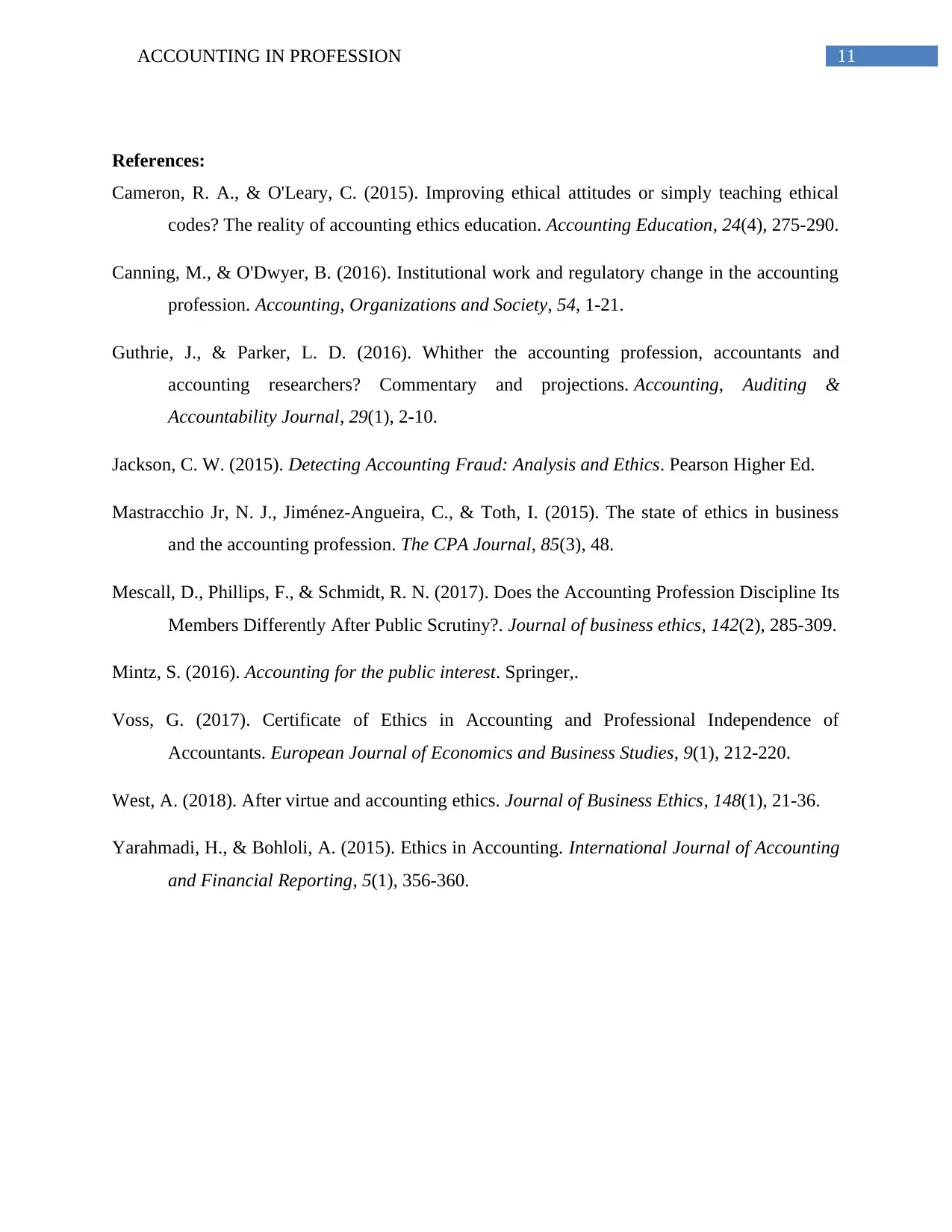
11ACCOUNTING IN PROFESSION
References:
Cameron, R. A., & O'Leary, C. (2015). Improving ethical attitudes or simply teaching ethical
codes? The reality of accounting ethics education. Accounting Education, 24(4), 275-290.
Canning, M., & O'Dwyer, B. (2016). Institutional work and regulatory change in the accounting
profession. Accounting, Organizations and Society, 54, 1-21.
Guthrie, J., & Parker, L. D. (2016). Whither the accounting profession, accountants and
accounting researchers? Commentary and projections. Accounting, Auditing &
Accountability Journal, 29(1), 2-10.
Jackson, C. W. (2015). Detecting Accounting Fraud: Analysis and Ethics. Pearson Higher Ed.
Mastracchio Jr, N. J., Jiménez-Angueira, C., & Toth, I. (2015). The state of ethics in business
and the accounting profession. The CPA Journal, 85(3), 48.
Mescall, D., Phillips, F., & Schmidt, R. N. (2017). Does the Accounting Profession Discipline Its
Members Differently After Public Scrutiny?. Journal of business ethics, 142(2), 285-309.
Mintz, S. (2016). Accounting for the public interest. Springer,.
Voss, G. (2017). Certificate of Ethics in Accounting and Professional Independence of
Accountants. European Journal of Economics and Business Studies, 9(1), 212-220.
West, A. (2018). After virtue and accounting ethics. Journal of Business Ethics, 148(1), 21-36.
Yarahmadi, H., & Bohloli, A. (2015). Ethics in Accounting. International Journal of Accounting
and Financial Reporting, 5(1), 356-360.
References:
Cameron, R. A., & O'Leary, C. (2015). Improving ethical attitudes or simply teaching ethical
codes? The reality of accounting ethics education. Accounting Education, 24(4), 275-290.
Canning, M., & O'Dwyer, B. (2016). Institutional work and regulatory change in the accounting
profession. Accounting, Organizations and Society, 54, 1-21.
Guthrie, J., & Parker, L. D. (2016). Whither the accounting profession, accountants and
accounting researchers? Commentary and projections. Accounting, Auditing &
Accountability Journal, 29(1), 2-10.
Jackson, C. W. (2015). Detecting Accounting Fraud: Analysis and Ethics. Pearson Higher Ed.
Mastracchio Jr, N. J., Jiménez-Angueira, C., & Toth, I. (2015). The state of ethics in business
and the accounting profession. The CPA Journal, 85(3), 48.
Mescall, D., Phillips, F., & Schmidt, R. N. (2017). Does the Accounting Profession Discipline Its
Members Differently After Public Scrutiny?. Journal of business ethics, 142(2), 285-309.
Mintz, S. (2016). Accounting for the public interest. Springer,.
Voss, G. (2017). Certificate of Ethics in Accounting and Professional Independence of
Accountants. European Journal of Economics and Business Studies, 9(1), 212-220.
West, A. (2018). After virtue and accounting ethics. Journal of Business Ethics, 148(1), 21-36.
Yarahmadi, H., & Bohloli, A. (2015). Ethics in Accounting. International Journal of Accounting
and Financial Reporting, 5(1), 356-360.
⊘ This is a preview!⊘
Do you want full access?
Subscribe today to unlock all pages.

Trusted by 1+ million students worldwide
1 out of 12
Related Documents
Your All-in-One AI-Powered Toolkit for Academic Success.
+13062052269
info@desklib.com
Available 24*7 on WhatsApp / Email
![[object Object]](/_next/static/media/star-bottom.7253800d.svg)
Unlock your academic potential
Copyright © 2020–2025 A2Z Services. All Rights Reserved. Developed and managed by ZUCOL.





